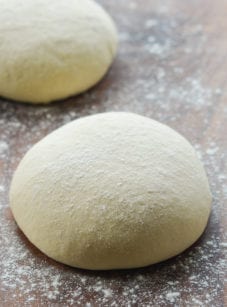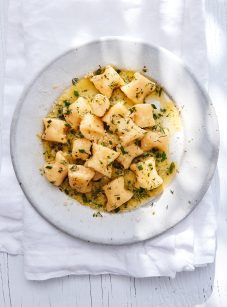Pierogi
This post may contain affiliate links. Read my full disclosure policy.
Learn to make authentic pierogi, the Polish dumplings filled with creamy potatoes and cheese, then topped with caramelized onions—a dish that’s as comforting as it is delicious!

Pierogi are a beloved staple of Polish cuisine, and it’s easy to see why—they’re comforting, delicious, and incredibly versatile. These half-moon-shaped dumplings are made from a simple dough and stuffed with savory or sweet fillings, then boiled and often pan-fried to perfection. Pierogi are so cherished that there are entire festivals dedicated to them, not just in Poland, but anywhere there’s a strong Polish community. You can find them filled with everything from potatoes, mushrooms, and cheese to meat or sauerkraut, but my favorite is the classic cottage cheese and mashed potato filling, topped with caramelized onions.
Making pierogi is simpler than it seems: brown the onions, make the dough, mix up the filling, and stuff and fold the dough into perfect little dumplings. After a quick boil and pan-fry, they’re golden and irresistible. Serve with fresh herbs and a dollop of sour cream, and watch them disappear!
Table of Contents
What You’ll Need To Make Pierogi

- All-Purpose Flour: Provides the structure for the dough. Measure by spooning it into the measuring cup and leveling it off to ensure accuracy.
- Water: Binds the ingredients together to form a pliable dough.
- Eggs: Adds richness and helps bind the dough.
- Butter: Used for sautéing the onions and frying the pierogi to prevent sticking and add a rich flavor.
- Onions: Add sweetness and depth to the filling and are scattered over the cooked pierogi adding a flavorful garnish.
- Mashed Potatoes: The creamy base of the filling; yellow potatoes are the best option but any kind will work. You’ll need 1 pound of potatoes, peeled and cut into ½-inch cubes. Boil the potatoes until tender, 10 to 12 minutes, then drain. Transfer back to the pot and heat over medium-low heat, mashing with a potato masher, until any moisture has evaporated, and the potatoes are mashed.
- Cottage Cheese: Adds creaminess and slight tang to the filling.
- Vegetable Oil: Prevents the cooked pierogi from sticking together.
- Fresh Parsley or Dill: Adds a fresh, herby finish when serving (optional).
- Sour Cream: Traditional accompaniment, adding a creamy, tangy flavor.
- Jump to the printable recipe for precise measurements
Step-By-Step Instructions
Step 1: Prepare the Dough
In a large bowl, mix the flour and salt.

Add the water into a liquid measuring cup that holds at least 2 cups of liquid. Add the eggs to the water and whisk with a fork until evenly combined.

Add the water/egg mixture to the dry ingredients.

Stir with a fork to evenly moisten until the ingredients.

Continue stirring until the ingredients come together into a loose, shaggy mass.

Using your hands, knead the dough in the bowl until it comes together into a ball. Lightly dust a clean work surface with flour. Invert the dough onto the surface and knead for 1 to 2 minutes, dusting with more flour as necessary, until smooth and elastic. Wrap the dough in plastic wrap and let rest at room temperature for 30 minutes.

Step 2: Make the Filling
Melt the butter in a medium skillet over medium heat. Add the onions to the melted butter and season with ⅛ teaspoon salt and a few grinds of black pepper. Cook, stirring frequently, until golden brown and softened, 8 to 10 minutes. Remove from the heat. Set aside about 1 cup of onions for the garnish.

In a medium bowl, combine the onions from the skillet with the mashed potatoes, cottage cheese, 1 teaspoon salt, and ¼ teaspoon black pepper. Mix well.

Step 3: Roll and cut the dough
Divide the dough into two even pieces. (Wrap one piece back in plastic wrap while you work with the other piece.) Dust some flour onto a clean work surface and onto a baking sheet (that will hold the pierogi), then roll out one portion of dough as thinly as possible, about 1/16 inch.

Using a 3-inch cookie cutter or inverted glass, cut out as many disks of dough as you can. Remove the scraps and wrap them in plastic wrap (you’ll re-roll them later).

Step 4: Assemble the Pierogi
Have a small bowl of water nearby to help moisten the dough edges if necessary. Working with one dough disk at a time, spoon a scant tablespoon of filling onto the center of the disk.

Fold the dough in half over the filling, creating a crescent shape.

To seal, pinch the top edges together firmly. Then continue sealing down both sides using a pinch-and-twist method: with your thumb and forefinger, pinch a small section of dough near the top, twist it slightly upward, and press it into the next section of dough. Repeat this pinch-and-twist motion all the way down both sides to create a secure, sealed, and very thin edge.

Once sealed, place the pierogi on the prepared baking sheet. Repeat this process for the remaining dough disks and filling. Work fairly quickly, as the pierogi can be harder to seal if they begin to dry out. Moisten the inside of half the disk only if necessary to help the dough adhere.
Unwrap the remaining dough and repeat the process. You can re-roll the scraps one time by forming them into a ball and rolling them out again, but avoid rolling them out more than once, as this can make the dough tough.

Step 5: Cook the Pierogi
Bring 3 quarts of salted water to a boil in a large pot over high heat. Add a single layer of pierogi to the boiling water, stirring gently to ensure they don’t stick together. Let them cook for 4 to 5 minutes. Use a slotted spoon or spider strainer to remove the pierogi from the pot.

Transfer the cooked dumplings to a tray or baking sheet and toss with a light coating of oil to prevent sticking. Repeat with the remaining pierogi.

To pan-fry the pierogi, work in batches. Melt 1 to 2 tablespoons of butter in a large skillet over medium-high heat until it begins to crackle. Add the boiled pierogi in a single layer, ensuring they don’t overlap, and cook until crisp and golden, 1 to 2 minutes per side. Repeat with the remaining pierogi, adding more butter as needed.

Serve hot, topped with reserved onions and parsley or dill (if using), and with sour cream on the side.

Frequently Asked Questions
Sure! Uncooked assembled pierogi can also be made ahead and kept in the refrigerator for up to two days. Place them in a single layer between sheets of parchment or wax paper in an airtight container, or on a baking sheet covered tightly with plastic wrap. To prevent sticking, be sure they don’t touch. The uncooked pierogi can also be frozen for up to 3 months. After sealing the pierogi, freeze them on the baking sheet until solid, a few hours. Transfer the frozen pierogi to an airtight container. When ready to cook, extend the boiling time to 7 to 8 minutes.
Yes, pierogi dough can be made up to 2 days ahead of time and stored in the refrigerator. Just make sure to wrap it tightly in plastic wrap or store it in an airtight container to prevent it from drying out. When you’re ready to use it, let the dough come to room temperature before rolling it out. You can also freeze the dough for longer storage—just thaw it in the fridge overnight before using.
Definitely! The options for pierogi fillings are virtually endless! While potato and cheese is a classic favorite, sauerkraut and mushrooms are also popular choices. Keep in mind that if you plan to use any veggies, they should first be finely chopped, seasoned, and sautéed. You can also get creative with the cheese and swap out cottage cheese for cheddar or ricotta. If you’re comfortable improvising, go for it, but if you feel more confident following a recipe, just do a quick search online for pierogi fillings.

You May Also Like
Pierogi
Learn to make authentic pierogi, the Polish dumplings filled with creamy potatoes and cheese, then topped with caramelized onions—a dish that’s as comforting as it is delicious!
Ingredients
For the Dough
- 4 cups all-purpose flour, spooned into measuring cup and leveled-off, plus more for kneading and rolling
- 1 teaspoon salt
- 1 cup room temperature water
- 2 large eggs
For the Filling
- 3 tablespoons unsalted butter
- 3 medium yellow onions (1½ pounds), finely diced
- Salt and freshly ground black pepper
- 1 cup mashed waxy potatoes, from 1 lb of yellow potatoes (see note)
- 1 cup cottage cheese
For Sautéing and Serving
- Vegetable oil (to prevent sticking)
- Unsalted butter
- Fresh parsley or dill
- Sour cream
Instructions
- Make the Dough: In a large bowl, mix the flour and salt. Add the water into a liquid measuring cup that holds at least 2 cups of liquid. Add the eggs to the water and whisk with a fork until evenly combined. Add the water/egg mixture to the dry ingredients and stir with a fork to evenly moisten until the ingredients come together into a loose, shaggy mass. Using your hands, knead the dough in the bowl until it comes together into a ball. Lightly dust a clean work surface with flour. Invert the dough onto the surface and knead for 1 to 2 minutes, dusting with more flour as necessary, until smooth and elastic. Wrap the dough in plastic wrap and let rest at room temperature for 30 minutes.
- Make the Filling: Melt the butter in a medium skillet over medium heat. Add the onions and season with ⅛ teaspoon salt and a few grinds of black pepper. Cook, stirring frequently, until golden brown and softened, 8 to 10 minutes. Remove from the heat. Set aside about 1 cup of onions for the garnish.
- In a medium bowl, combine the onions from the skillet with the mashed potatoes, cottage cheese, 1 teaspoon salt, and ¼ teaspoon pepper. Mix well.
- Roll and cut the dough: Divide the dough into two even pieces. (Wrap one piece back in plastic wrap while you work with the other piece.) Dust some flour onto a clean work surface and onto a baking sheet (that will hold the pierogi), then roll out one portion of dough as thin as possible, about 1/16 inch. Using a 3-inch cookie cutter or inverted glass, cut out as many disks of dough as you can. Remove the scraps and wrap them in plastic wrap (you'll re-roll them later).
- Assemble the pierogi: Have a small bowl of water nearby to help moisten the dough edges if necessary. Working with one dough disk at a time, spoon a scant tablespoon of filling onto the center of the disk. Fold the dough in half over the filling, creating a crescent shape. To seal, pinch the top edges together firmly. Then continue sealing down both sides using a pinch-and-twist method: with your thumb and forefinger, pinch a small section of dough near the top, twist it slightly upward, and press it into the next section of dough. Repeat this pinch-and-twist motion all the way down both sides to create a secure, sealed, and very thin edge. Once sealed, place the pierogi on the prepared baking sheet. Repeat this process for the remaining dough disks and filling. Work fairly quickly, as the pierogi can be harder to seal if they begin to dry out. Moisten the inside of half the disk only if necessary to help the dough adhere.
- Unwrap the remaining dough and repeat the process. You can re-roll the scraps one time by forming them into a ball and rolling them out again, but avoid rolling them out more than once, as this can make the dough tough.
- Cook the pierogi: In a large pot, bring 3 quarts of salted water to a boil over high heat.
- Add a single layer of pierogi to the boiling water, stirring gently to ensure they don't stick together. Let them cook for 4 to 5 minutes. Use a slotted spoon or spider strainer to transfer the cooked dumplings to a tray or baking sheet and toss with a light coating of oil to prevent sticking. Repeat with the remaining pierogi.
- If you'd like to pan-fry the pierogi after boiling them, work in batches. Melt 1 to 2 tablespoons of butter in a large skillet over medium-high heat until it begins to crackle. Add the boiled pierogi in a single layer, ensuring they don't overlap, and cook until crisp and golden, 1 to 2 minutes per side. Repeat with the remaining pierogi, adding more butter as needed. Serve hot, topped with reserved onions and parsley or dill (if using), and with sour cream on the side.
- Make-Ahead/Freezer-Friendly Instructions: Pierogi dough can be made up to 2 days ahead of time and stored in an airtight container in the refrigerator. When you’re ready to use it, let the dough come to room temperature before rolling it out. You can also freeze the dough for longer storage—just thaw it in the fridge overnight before using. Uncooked assembled pierogi can also be made ahead and kept in the refrigerator for up to two days. Place them in a single layer between sheets of parchment or wax paper in an airtight container, or on a baking sheet covered tightly with plastic wrap. Be sure they don't touch to prevent sticking. The uncooked pierogi can also be frozen for up to 3 months. After sealing the pierogi, freeze them on the baking sheet until solid, a few hours. Transfer the frozen pierogi to an airtight container. When ready to cook, extend the boiling time to 7 to 8 minutes.
- Note: To get 1 cup of mashed potatoes, you’ll need to begin with 1 pound of yellow potatoes, peeled and cut into ½-inch cubes. Bring a medium pot of water to a boil. Add the potatoes and boil until tender, 10 to 12 minutes. Drain in a colander, then transfer back to the pot and heat over medium-low heat, mashing with a potato masher, until any moisture has evaporated, and the potatoes are mashed, 1 to 2 minutes.
- Note: Nutritional information does not include sautéing or optional serving ingredients.
Nutrition Information
Powered by ![]()
- Per serving (23 servings)
- Serving size: 2 pierogi
- Calories: 126
- Fat: 3 g
- Saturated fat: 1 g
- Carbohydrates: 21 g
- Sugar: 2 g
- Fiber: 1 g
- Protein: 4 g
- Sodium: 203 mg
- Cholesterol: 22 mg
This website is written and produced for informational purposes only. I am not a certified nutritionist and the nutritional data on this site has not been evaluated or approved by a nutritionist or the Food and Drug Administration. Nutritional information is offered as a courtesy and should not be construed as a guarantee. The data is calculated through an online nutritional calculator, Edamam.com. Although I do my best to provide accurate nutritional information, these figures should be considered estimates only. Varying factors such as product types or brands purchased, natural fluctuations in fresh produce, and the way ingredients are processed change the effective nutritional information in any given recipe. Furthermore, different online calculators provide different results depending on their own nutrition fact sources and algorithms. To obtain the most accurate nutritional information in a given recipe, you should calculate the nutritional information with the actual ingredients used in your recipe, using your preferred nutrition calculator.






Jen. I love your recipes but it’s time to start weighing ingredients to ensure accuracy every time
Glad you like the recipes! The great majority of my recipes (including this one) include conversions to metric/weight measurements. To view them, scroll down to the recipe, and immediately under the recipe title on the right side, you’ll see a little toggle. If you move it from “cup measures” to metric, you’ll see measurements that will work for you. Hope that helps!